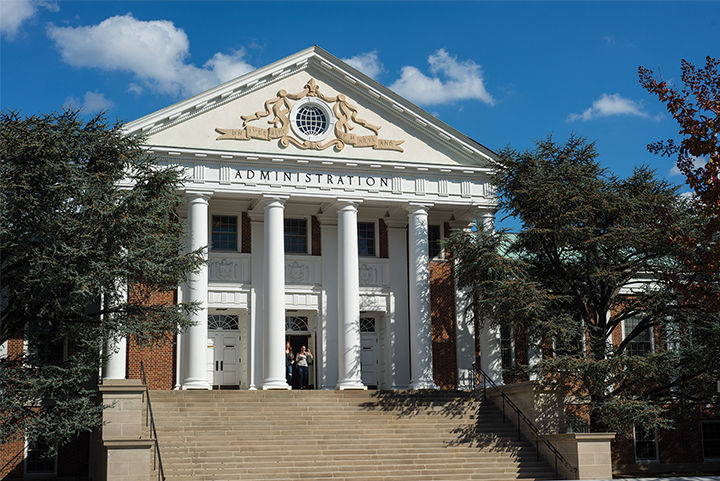At a meeting on Thursday where many criticized the University of Maryland’s administration for a lack of transparency regarding hate bias incidents, students revealed a nearly two-week-old incident involving a Confederate flag etching in a dorm bathroom.
Chief Diversity Officer Roger Worthington confirmed with The Diamondback that an apparent Confederate flag was found carved into a stall in the third-floor men’s bathroom in Somerset Hall, which houses the CIVICUS program. CIVICUS Director Korey Rothman sent an email about the incident to the program community on Nov. 6, the same day she was made aware of it.
In September, Worthington announced the creation of the Student Leadership Council for Diversity, Equity, and Inclusion in an email sent to the university community. The Office of Diversity and Inclusion reached out to student leaders in various organizations to welcome them to the council, which would meet once a month to discuss actions the university administration could take to push for diversity and inclusion, Worthington told The Diamondback.
On Thursday, the council met with the Office of Diversity and Inclusion in Marie Mount Hall for the first time as part of this university’s initiatives to address hate, bias and diversity and inclusion issues on the campus.
Many students at the meeting expressed frustration that this university didn’t notify the largest campus community about the incident.
[Read more: Former UMD employee charged with malicious property destruction in swastika incident]
“Nobody really knew about the situation that happened,” said Zach Caplan, a CIVICUS member. “The fact that staff members on campus didn’t know. The fact that members in the counseling center didn’t know, even though there were students who had to go to the counseling center to receive counseling on that issue.”
Rothman’s email to CIVICUS said the Department of Resident Life was working with University of Maryland Police for the investigation into and removal of the carving.
“I would hope to see more transparency in the situations with hate speech on campus and I would like to see more of an understanding that people should know what’s happening and it’s not just something the university is trying to contain to cover their asses,” said Caplan, a freshman government and politics major.
The Office of Diversity and Inclusion is working to create a reporting system where students who want to hear of hate bias incidents can opt in to receive alerts, Worthington announced at the meeting.
[Read more: UMD President Loh announces action plan to “combat hate and create a safer campus”]
Tomiwa Sobande, a Somerset Hall resident, said the lack of transparency about the etching incident helped foster the fear officials tried to prevent.
“I don’t like the way what happened at Somerset was kind of contained and only we knew,” said Sobande, a freshman English and psychology major in CIVICUS. “It was badly handled.”
Timea Webster, the Office of Diversity and Inclusion’s executive administrative assistant, asked students how they believe this university should respond to hate bias incidents when the perpetrator is unknown. Webster said the “hard truth” is that the university does not know who the perpetrator is in many hate bias incidents.
“What do you do? What is a robust response?” Webster said. “Personally, I’m like, ‘Kick them all off,’ but who are they?”
Several students said they did not think the university offered adequate assurances that hate speech will be addressed and curtailed.
“The fact that I don’t know what should happen to a person if they get caught putting up hate speech is a problem,” said Saba Tshibaka, a sophomore computer science major who was representing the Ethiopian Eritrean Students Association and Black Honors Caucus. “If I cheat in a class, I know exactly what’s gonna happen to me. [Punishments for hate bias incidents are] not clearly labeled out.”
A protocol detailing how this university should respond to hate bias incidents will be released within about a week, Worthington said at the meeting.
Worthington told The Diamondback that the protocol went through its final stage for approval this week, and that he and university President Wallace Loh have both seen it. Several administrative groups across campus, including the Office of Diversity and Inclusion and the Office of Civil Rights and Sexual Misconduct, came together to create it, Worthington said.
Karla Casique, a senior journalism major representing the American Indian Student Union, said she’s felt ignored in her four years at the university.
“There has been no form of protection,” Casique said. “I personally have lost faith in administration and other people in authority because of the hours of work and dedication we put in and we haven’t been paid for it and a lot of us have been ridiculed for it.”
Casique cited several incidents she felt the administration handled poorly during her time at this university, including University Police’s usage of pepper spray at a party with predominantly black attendees in May 2016, and an offensive email sent in January 2014 from a then-member of this university’s Kappa Sigma fraternity chapter.
Taylor Green, representing undergraduate studies for the Student Government Association, called the campus “eerily calm” following the uptick in hate bias incidents.
“Students right now feel very disenfranchised,” Green said, “and I feel like it’s only a matter of time before an incident happens that causes the campus to go up in flames.”



